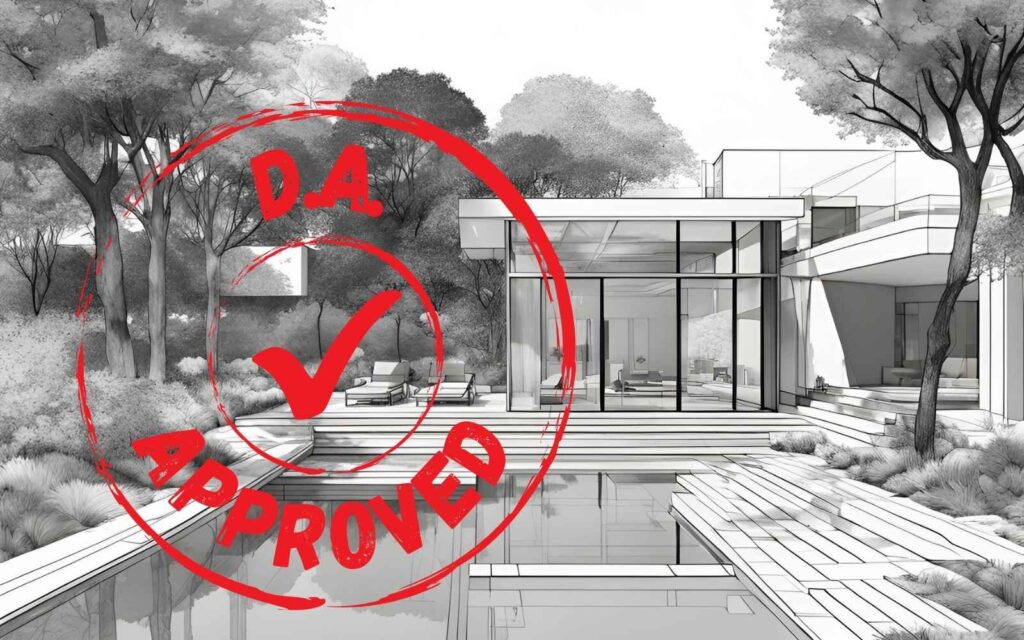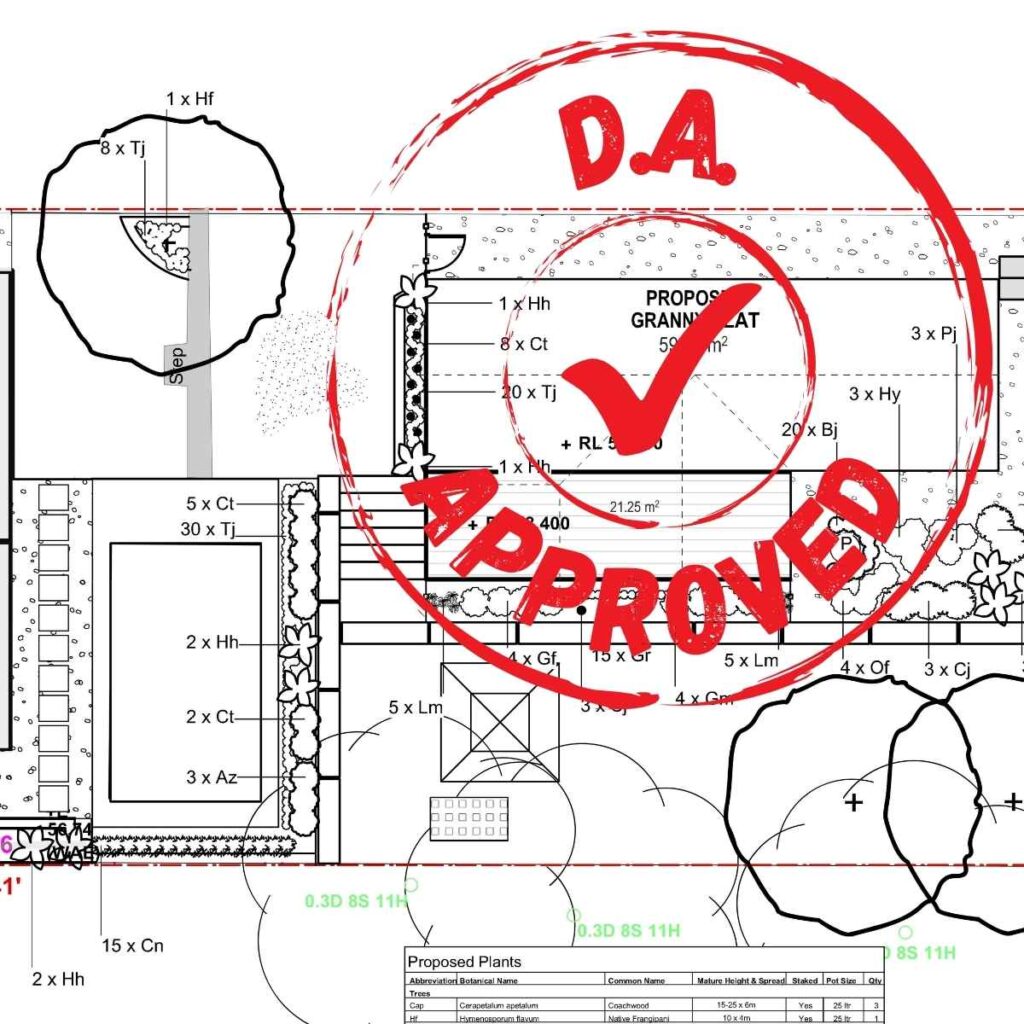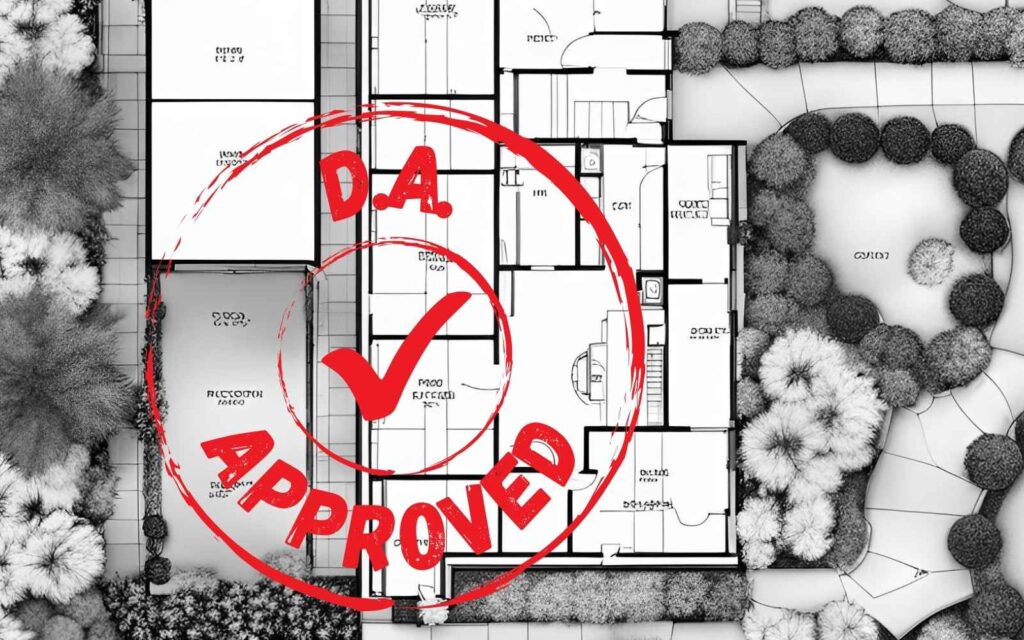MY Tips
How to Get Your Landscape
Plans Through DA Approval
in New South Wales
Navigating the Development Application (DA) process for landscape plans in NSW can be challenging, but with preparation and the right strategy, you can ensure a smoother approval process. This guide from Your Landscape Journey provides a detailed roadmap, focusing on compliance, organisation, and sustainability to help you succeed.
1. Understanding DA Approval in NSW
A DA is required for projects that impact the environment or urban landscape. Unlike Complying Development Certificates (CDC), DAs are subject to individual council assessments, making it essential to align your design with Local Environmental Plans (LEPs) and Development Control Plans (DCPs).
These regulations provide guidance on setbacks, tree preservation, and hardscaping elements to ensure your project supports local environmental and planning goals.

2. Preparing a Comprehensive Landscape Plan
Your landscape plan must be comprehensive and include the following components:
Site Analysis:
Highlight key features such as slopes, drainage, and vegetation.Concept Plan:
Provide a visual layout that reflects the spatial organisation of the landscape.Planting Plan:
Specify plant types, their sizes, and ecological functions (e.g., shade or habitat).Irrigation and Drainage Strategy:
Detail water management practices, including WSUD elements like rain gardens.Maintenance Plan:
Outline long-term care to ensure plant health and compliance with council requirements.
Site Coverage Plan for Hard Ratios
An essential part of your landscape submission is the site coverage plan, detailing the ratio of hard to soft landscaping. Each council must be checked for the coverage that is required
Soft Landscaping:
Includes lawns, garden beds, and tree planting areas with permeable surfaces.
Hard Landscaping:
Covers non-permeable areas such as paving, swimming pools, and driveways.
A balanced coverage ensures environmental resilience and enhances the visual character of the property. Including a detailed site coverage plan in your DA submission helps align with these guidelines, improving your chances of approval.
3. Navigating Council Regulations and Planning Instruments
Councils use LEPs and DCPs to guide development and maintain local character. These regulations cover:
- Zoning
- Tree preservation rules and setbacks
- Requirements for built elements
- Stormwater management guidelines
- Use of native species to promote local biodiversity
Use the NSW Planning Portal to determine applicable planning instruments and research whether your site is in a bushfire-prone or heritage area, which may require additional compliance steps.

4. Engaging Professionals Early
Consulting with landscape designers, arborists, and horticulturalists early can prevent costly mistakes and ensure smooth approvals. Experts can assist with:
- Tree retention assessments
- Bushfire safety compliance for rural properties
- Stormwater solutions for challenging sites
Proactively working with professionals ensures your design meets both aesthetic goals and council requirements.
5. Addressing Environmental and Sustainability Requirements
Councils prioritise sustainable landscaping practices. Your design should align with Water Sensitive Urban Design (WSUD) principles by incorporating:
- Drought-tolerant plants and native species to reduce water usage
- Permeable surfaces for effective stormwater absorption
- Bioswales or rain gardens for natural water management
These strategies promote long-term sustainability and demonstrate a commitment to environmental responsibility, which can positively influence council decisions.
6. Complying with Tree Preservation Rules
Strict Tree Preservation Orders (TPOs) in NSW regulate the removal of significant trees. To comply, you may need:
- Arborist reports assessing tree health and justifying removal
- Replacement planting plans to maintain canopy cover and biodiversity
- Coordination with local councils to align your design with vegetation management policies

7. Dealing with Council Feedback
It’s common for councils to request amendments to your submission. To keep the process moving smoothly:
- Review feedback carefully with your team and make necessary changes promptly.
- Communicate with council officers to clarify any issues.
- Submit supplementary reports if required, such as bushfire or soil assessments.
Being responsive and organised ensures your project stays on track and avoids delays.
8. Using Checklists to Stay Organised
Staying organised with checklists ensures you’ve covered all the essential components of your submission. Your checklist should include as a start :
- Completed DA application form
- Site coverage plan with hard-to-soft ratios
- Arborist and environmental reports (if applicable)
- Stormwater management documentation
- Fee payments and permits
Your Landscape Journey offers practical templates and checklists to streamline your DA application, ensuring no detail is overlooked.
9. Common Mistakes to Avoid
To avoid delays and increase your chances of approval, watch out for these common mistakes:
- Incomplete plans: Ensure all components are accurate and well-documented.
- Non-compliance with regulations: Double-check that your design aligns with local LEPs and DCPs.
- Ignoring tree preservation rules: Engage an arborist early if the site contains significant vegetation.
- Delays in responding to council feedback: Stay proactive and meet deadlines to avoid unnecessary setbacks.
Conclusion
Securing DA approval for your landscape plans in NSW requires careful preparation and attention to detail. By submitting comprehensive plans, engaging professionals, and aligning with sustainability principles, you can improve your chances of success.
For more resources and tools to guide your landscape journey, explore the checklists and templates available at Your Landscape Journey. With proactive planning and the right support, you can bring your landscape vision to life while meeting council requirements efficiently.
Start your journey today—get your plans approved and be ready to thrive in 2025!
Our recommendations and information provided in our articles, blog and on this website is intended to be educational and informative only. It is at no time to be relied upon as personal advice for your own situation. While we try our best to ensure that the information is accurate, sometimes it may not be suitable or correct for your particular circumstances or the products or services you may choose to purchase.
Any comments, guidance, or information on this website is our own view and based on our experience and we do not provide any guarantees, warranties relating to any aspect of the information, including but not limited to any reliance on the safety or security of any landscape recommendations, renovations, designs, plant use or any particular installations. We hope you find it helpful but please be aware that it may not be suitable for your situation, location, surroundings or other specific needs. This information is offered in good faith and it is not specific to any one person or any personal circumstance. You should contact us directly so we may review and assess your own situation to be able to provide recommendations specific to your own requirements, particularly if you are in a fire, drought or other sensitive area.
We hope you understand that for this reason, we are not to be held liable for any decisions you make based on any of the information, views, or recommendations on our website and in our blog articles and any consequences, as a result, are your own.
The information shown and posted on this website or expressed by either the moderator is the view of the person(s) posting only and is intended to be examples only and not advice for you personally.
Any decisions or information on this website you decide to use, read or act upon is done at your own risk and you shall indemnify yourlandscapejourney.com, its directors and employees for any and all claims whether resulting directly or indirectly from your actions.





